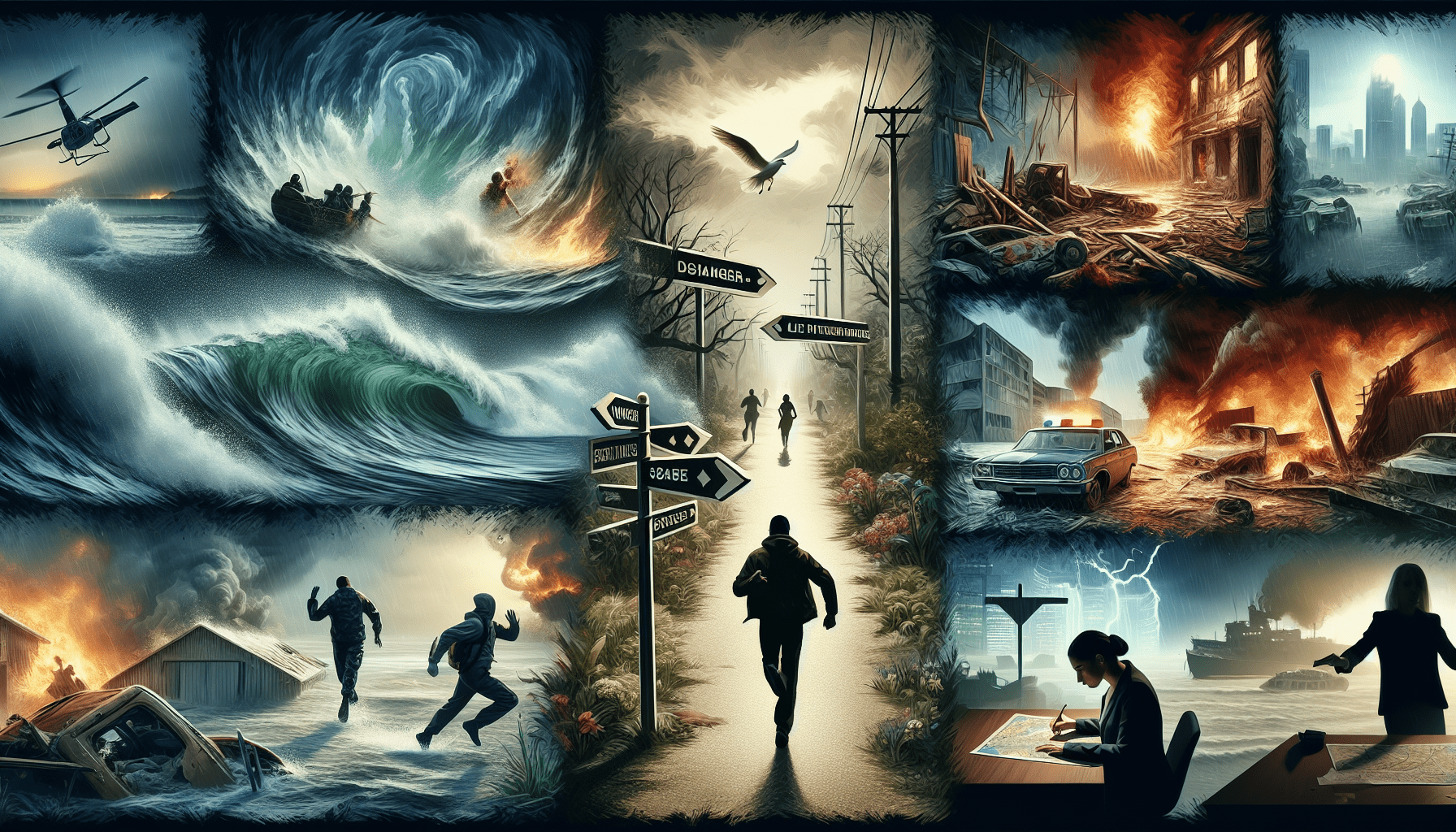Imagine finding yourself in a dangerous situation where your safety is at risk. You may feel overwhelmed and unsure of how to protect yourself. However, there are several simple yet effective strategies you can employ to escape from such a threatening predicament. This article will guide you through practical techniques and precautions that can empower you to swiftly navigate out of harm’s way. From recognizing warning signs to utilizing your surroundings, these invaluable tips will equip you with the knowledge and skills to stay safe and maintain a calm demeanor when faced with danger.
Stay Calm
In any dangerous situation, it’s crucial to stay calm. Panicking and letting fear take over can cloud your judgement and hinder your ability to make rational decisions. Take a deep breath and try to control your emotions. By staying calm, you can better assess the threat and come up with an effective plan to keep yourself safe. Remember, keeping a clear mind is key.
Control your emotions
When faced with a dangerous situation, it’s natural for your emotions to run high. However, it’s important to try to control them as best you can. Take a moment to acknowledge your feelings, but then focus on maintaining a level head. By controlling your emotions, you can think more clearly and appropriately respond to the situation at hand.
Take deep breaths
Deep breathing exercises can help you stay calm and centered in a dangerous situation. By taking deep, slow breaths, you can regulate your heart rate and reduce anxiety. Inhale deeply through your nose, hold for a few seconds, and then exhale through your mouth. Repeat this process to help calm your nerves and maintain your composure.
Focus on the present moment
While it’s natural for your mind to race and think about the worst-case scenario, it’s important to focus on the present moment. Instead of worrying about what might happen, concentrate on what you can do right now. By staying in the present, you can better assess the situation and take the necessary steps to protect yourself.
Assess the Threat
When faced with danger, it’s crucial to accurately assess the threat. Identifying the danger is the first step in coming up with an effective plan of action. Evaluate the severity of the situation by considering the potential harm it may cause. Is it a physical threat? Is it a potentially dangerous individual? Understanding the nature of the threat can help you respond in the most appropriate manner.

Identify the danger
Look around and try to identify the specific danger you’re facing. Is it an aggressive person, a natural disaster, or some other immediate threat? By pinpointing the danger, you can better understand how to respond. For example, an aggressive person may require a different approach than escaping from a burning building.
Evaluate the severity of the situation
Once you’ve identified the danger, it’s essential to evaluate how severe the situation is. Assess the potential harm or danger the situation poses to you and others. Understanding the severity can guide your decision-making process and help you determine the best course of action.
Consider any potential escape routes
In a dangerous situation, it’s important to consider all possible escape routes. Look for exits, windows, or any other openings that can provide a way out. Evaluate each potential escape route based on its safety and feasibility. Having multiple options can increase your chances of successfully escaping the danger.
Create Distance
Creating distance between yourself and the threat is crucial for your safety. By putting physical barriers between you and the danger, you can buy yourself time and potentially deter the aggressor. Seek ways to create distance, such as moving to another room, barricading doors, or finding objects to put between you and the danger.
Move away from the threat
The first step in creating distance is to move away from the immediate threat. If possible, create space between yourself and the danger by moving in the opposite direction. By increasing the physical distance, you reduce the chance of harm and gain more time to react.

Put physical barriers between you and the danger
In addition to moving away, it’s crucial to put physical barriers between yourself and the danger. Look for objects such as tables, chairs, or anything else that can act as a barrier. By creating obstacles, you can slow down the aggressor and gain crucial seconds to either escape or seek help.
Create obstacles to slow down the aggressor
If you find yourself being pursued by an aggressor, try to create obstacles to slow them down. Knock over objects, throw items in their path, or make it difficult for them to reach you. By creating obstacles, you increase the chances of either escaping or getting help before they can reach you.
Seek Help
When in a dangerous situation, it’s important to reach out for assistance. Don’t hesitate to seek help from others who can take immediate action and ensure your safety. Remember, you don’t have to face the danger alone.
Call emergency services
If you’re in immediate danger and need urgent assistance, call emergency services. Dial the emergency number for your location (such as 911 in the United States) and provide them with a concise description of the threat and your location. Emergency services are trained to handle dangerous situations and can dispatch the appropriate responders to help you.
Notify authorities or security personnel
If you’re in a public place or a building with security personnel, notify them immediately. Alerting authorities or security personnel can expedite their response and provide you with additional protection. Inform them about the nature of the threat and your location so they can take appropriate action.

Yell for assistance
If you’re unable to call for help or don’t have immediate access to emergency services, yelling for assistance can be an effective way to gain attention. Raise your voice and shout for help, making it clear that you’re in danger and need immediate assistance. In some cases, bystanders or nearby individuals may be able to intervene or call for help on your behalf.
Find a Safe Place
In a dangerous situation, finding a safe place is crucial. Locate an area where you can seek refuge and minimize your exposure to harm. When choosing a safe place, consider factors such as accessibility, concealment, and the level of protection it offers.
Locate a secure area
When seeking a safe place, aim for an area that offers security and protection. Look for rooms with sturdy doors that can be locked, preferably with minimal entry points. Bathrooms, offices, or storage areas can often provide secure locations. Remember to consider escape routes within the secure area as well.
Hide or take cover in a discreet spot
Once you’ve found a secure area, it’s important to hide or take cover in a discreet spot within that area. Stay away from windows or other areas that provide a direct line of sight. Find a place where you can stay concealed and reduce the chances of being seen by the aggressor.
Avoid being seen or heard
In a safe place, it’s crucial to minimize the chances of being seen or heard. Stay quiet and avoid making unnecessary sounds or movements that may alert the aggressor to your presence. Silence your phone and turn off any notification sounds to maintain a low profile.

Use Self-Defense Techniques
Knowing basic self-defense techniques can be invaluable in a dangerous situation. While avoiding confrontation is always the best option, being prepared to defend yourself when necessary can increase your chances of staying safe.
Learn basic self-defense moves
Consider taking self-defense classes or learning basic self-defense moves. Techniques such as strikes to vulnerable areas like the eyes, nose, throat, and groin can temporarily incapacitate an attacker, giving you an opportunity to escape.
Use objects as improvised weapons
In a life-threatening situation, everyday objects can become improvised weapons. Look for items you can use to defend yourself, such as a heavy flashlight, a pen, or even keys. Aim for vulnerable areas on the aggressor’s body, such as the eyes, nose, or throat, to increase your chances of disabling them.
Target vulnerable points on the aggressor’s body
If you find yourself facing an aggressor, focus on targeting vulnerable points on their body. This can include striking or applying pressure to areas such as the eyes, nose, throat, or groin. By attacking these areas, you can potentially disable the aggressor and create an opportunity to escape.
Stay Aware of Your Surroundings
Being aware of your surroundings is essential in staying safe and avoiding dangerous situations. Paying attention to your environment can help you identify potential threats and allow you to take proactive measures to protect yourself.

Pay attention to your environment
Be mindful of your surroundings at all times, even in familiar places. Stay alert and observe the people and objects around you. Look for any suspicious behavior or signs of danger. By maintaining awareness, you can detect potential threats early on and take appropriate action.
Avoid isolated or poorly lit areas
When possible, avoid isolated or poorly lit areas. Stick to well-populated areas with good lighting. Criminals often target individuals who are alone or in places where they can operate without being seen. By staying in well-populated areas, you reduce the risk of encountering dangerous situations.
Listen for signs of danger
Listen carefully to your surroundings for any unusual sounds or signs of danger. Pay attention to footsteps, voices, or anything that seems out of place. Trust your instincts and be prepared to react quickly if you sense danger. By staying alert, you can better protect yourself and respond to potential threats.
Make Noise
In a dangerous situation, making noise can be a vital way to attract attention and get help. It can startle the aggressor, alert nearby individuals, and increase the chances of someone coming to your aid.
Scream or shout for help
If you’re in immediate danger and need assistance, scream or shout for help. Make your voice as loud and clear as possible to attract attention. Shouting specific words such as “Help!” or “Fire!” can be more effective in eliciting a response from others.
Activate personal safety alarms
Carrying a personal safety alarm can be an effective way to attract attention and deter an aggressor. These small devices emit a loud noise when activated, which can startle the aggressor and alert nearby individuals to the danger you’re facing.
Bang on objects to attract attention
If you don’t have a personal safety alarm, you can still make noise by banging on nearby objects. Look for items such as doors, walls, or metal surfaces that will produce a loud sound when struck. Creating noise can quickly draw attention and increase the likelihood of someone coming to your aid.
Stay Connected
In today’s digital age, staying connected can be a lifeline in a dangerous situation. By utilizing your smartphone and informing others about your whereabouts, you can enhance your safety and increase the chances of getting help quickly.
Keep your phone charged and easily accessible
Ensure that your phone is always charged and easily accessible, especially when you’re out and about. Having a fully charged phone allows you to call for help at a moment’s notice. Keep it in an easily reachable pocket or bag, so you can quickly retrieve it when needed.
Inform someone you trust about your whereabouts
Before heading out alone, let someone you trust know your exact location and estimated return time. Provide them with details about where you’re going and who you’ll be with. Informing someone you trust increases the chances of them knowing if something goes wrong and enables them to take appropriate action.
Use GPS tracking apps if available
Consider using GPS tracking apps that allow trusted individuals to monitor your location in real-time. These apps can provide an added layer of security, as your loved ones can keep track of your movements and respond swiftly if you’re in danger. Explore different tracking apps available for your smartphone and choose one that best suits your needs.
Follow Your Instincts
Above all else, trust your instincts in a dangerous situation. Your gut feelings are often a reliable guide and can help you make the right decisions to protect yourself.
Trust your gut feelings
If something feels off or makes you uncomfortable, trust your gut. Our intuition is a powerful tool that can alert us to potential danger. If a situation or person feels threatening, take it seriously and take the necessary steps to remove yourself from harm’s way.
Don’t ignore warning signs
In dangerous situations, warning signs are often present. Whether it’s a person’s aggressive behavior, an unfamiliar situation, or a gut feeling that something is wrong, pay attention to these signs. Ignoring warning signs can put you at greater risk. Trust your instincts and respond accordingly.
Prioritize your personal safety above all else
In any dangerous situation, your personal safety should always be your top priority. Take whatever actions are necessary to protect yourself, even if it means making difficult decisions or temporarily inconveniencing others. Your well-being is of the utmost importance, so trust yourself and take the steps required to stay safe.
Remember, escaping a dangerous situation requires a combination of awareness, preparation, and quick thinking. Stay calm, assess the threat, create distance, seek help, find a safe place, utilize self-defense techniques, stay aware of your surroundings, make noise, stay connected, and trust your instincts. By following these guidelines, you can increase your chances of successfully escaping a dangerous situation and keeping yourself safe.
